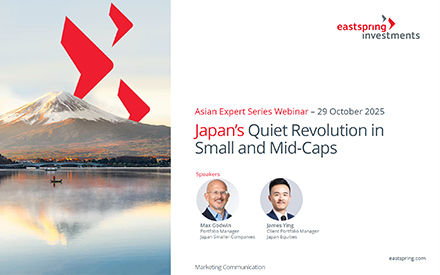Executive Summary
My recent trip to Japan where I met up with 7 corporates reaffirmed the bond team’s conviction that there are opportunities within Japanese corporate bonds for active managers to deliver off-benchmark alpha. Here are my key takeaways:
- Inflation is real, but the heightened uncertainty triggered by US tariffs and China’s retaliation poses a growth risk and may affect the BoJ’s rate hike trajectory.
- Automakers with higher EBITDA margins, competitive positioning in hybrids and that sell to diversified global markets should be able to better navigate the tariffs.
- Retailers’ pricing decisions in the face of tariffs will depend on competitors' actions and prevailing consumer sentiment.
Japanese USD-denominated bonds gained greater prominence among investors after J.P. Morgan introduced the JACI Asia Pacific Index in March 2023. The healthy issuance of Japanese corporate bonds in recent years also helped to fill the gap left by Chinese issuers. Japanese bonds’ relatively high quality and low duration characteristics, coupled with their low correlations with many other Asian bond markets have further increased their appeal.
With the uncertainty posed by the recently announced US trade tariffs on Japanese exports, wage and inflation trends, it was timely to visit Japan to gain first-hand insights from its corporates. The fact that the cherry blossoms were in full bloom did not hurt.
The rate hike dilemma
Inflation is very real. My favorite fruit mille crepe cake is definitely more expensive compared to what I remember.
The rise in core CPI inflation in March, combined with the recent surge in fresh food prices should give the Bank of Japan (BoJ) more conviction that inflation is nearing its 2% target. The acceleration in services inflation indicates that robust wage growth will continue to drive consumer prices higher.
However, the heightened uncertainty and market instability triggered by the US’ tariff increases and China’s retaliation – Japan’s two biggest trade partners - pose a risk to growth and may affect the BoJ’s rate hike trajectory.
Business sentiment appears more cautious. While earnings and margins are still relatively healthy1, Japanese corporates are experiencing rising leverage and a slight deterioration in credit worthiness. Active management would be even more important in navigating the market in the days ahead.
Decoding tariffs
Automobile makers, capital goods manufacturers and retailers appear most affected by US tariffs. However, conversations with corporates and analysts suggest that the impact of tariffs is more nuanced, and one must dig deeper beyond the tariff headlines.
Automobiles - The automobile sector made up the largest proportion of US exports at 25%, accounting for ¥5.8 trillion in 2024. Auto parts, with ¥1.1 trillion, made up 5.5%. The increase in tariffs is likely to reduce the profitability of major Japanese automakers. Passing on the costs of the higher tariffs would result in higher prices and hurt demand.
That said, automakers that sell to diversified global markets and that have higher EBITDA margins should be able to better absorb the tariff impact. Those with competitive positioning in hybrid cars would potentially find it easier to pass on the higher costs. In this environment, a strong financial profile would help maintain issuers’ credit ratings. Conversely, automakers with higher US exposure and relatively weaker margins would be more adversely affected by the tariffs.
Capital goods manufacturers - power generating machines are the third largest sector in terms of exports to the US, followed by construction machinery. Apart from companies that have a high local production ratio, higher tariffs are likely to depress profits for major capital goods manufacturers.
Trading companies – On the other hand, tariffs are likely to have negligible direct impact on trading companies as they run a fee-based business and should be able to pass on the additional tariff costs. Their earnings however are likely to be hit by yen appreciation, resource price adjustments and lower handling volumes. Trading companies with larger exposures to resources are likely to experience higher volatility.
Most of the large Japanese trading companies with international operations tend to have strong financial positions and diversified businesses which should help them withstand the tariff impact.
Gone shopping
Japan is home to many well-known retail brands that are popular both domestically and internationally. For brands that have global ambitions, the North American market is an important one. This is the case for a popular Japanese sports brand even though its current operating margins in North America are amongst the lowest across the different markets it sells to, due to intense competition and high advertising costs.
Most of the company's production takes place at Original Equipment Manufacturer (OEM) factories in Southeast Asia, which are subject to US reciprocal tariffs. Products manufactured in Chinese facilities are solely for the Chinese market. The company’s game plan going forward includes:
- Stockpiling during the 90-day tariff pause.
- Try to partially offset the negative impact on margins by increasing prices, reducing discounts, and/or selling fewer entry-level models. That said, pricing decisions will depend on competitors' actions and prevailing consumer sentiment.
- On the production front, the company may increase or relocate production to locations with lower tariffs.
Seeking off-benchmark alpha
My trip reaffirmed the team’s conviction that there are opportunities within Japanese corporate bonds for active managers to deliver off-benchmark alpha. Technicals are currently in our favour as bond issuance slows amidst the uncertainty of tariff negotiations. We stay short to mid duration while positioning ourselves within the more defensive sectors. Till the next visit to Japan – sayonara!
Sources:
1 Earnings before Interest, Tax, Depreciation and Amortisation (EBITDA) and EBITDA margins.
The information and views expressed herein do not constitute an offer or solicitation to deal in shares of any securities or financial instruments and it is not intended for distribution or use by anyone or entity located in any jurisdiction where such distribution would be unlawful or prohibited. The information does not constitute investment advice or an offer to provide investment advisory or investment management service or the solicitation of an offer to provide investment advisory or investment management services in any jurisdiction in which an offer or solicitation would be unlawful under the securities laws of that jurisdiction.
Past performance and the predictions, projections, or forecasts on the economy, securities markets or the economic trends of the markets are not necessarily indicative of the future or likely performance of Eastspring Investments or any of the strategies managed by Eastspring Investments. An investment is subject to investment risks, including the possible loss of the principal amount invested. Where an investment is denominated in another currency, exchange rates may have an adverse effect on the value price or income of that investment. Furthermore, exposure to a single country market, specific portfolio composition or management techniques may potentially increase volatility.
Any securities mentioned are included for illustration purposes only. It should not be considered a recommendation to purchase or sell such securities. There is no assurance that any security discussed herein will remain in the portfolio at the time you receive this document or that security sold has not been repurchased.
The information provided herein is believed to be reliable at time of publication and based on matters as they exist as of the date of preparation of this report and not as of any future date. Eastspring Investments undertakes no (and disclaims any) obligation to update, modify or amend this document or to otherwise notify you in the event that any matter stated in the materials, or any opinion, projection, forecast or estimate set forth in the document, changes or subsequently becomes inaccurate. Eastspring Investments personnel may develop views and opinions that are not stated in the materials or that are contrary to the views and opinions stated in the materials at any time and from time to time as the result of a negative factor that comes to its attention in respect to an investment or for any other reason or for no reason. Eastspring Investments shall not and shall have no duty to notify you of any such views and opinions. This document is solely for information and does not have any regard to the specific investment objectives, financial or tax situation and the particular needs of any specific person who may receive this document.
Eastspring Investments Inc. (Eastspring US) primary activity is to provide certain marketing, sales servicing, and client support in the US on behalf of Eastspring Investment (Singapore) Limited (“Eastspring Singapore”). Eastspring Singapore is an affiliated investment management entity that is domiciled and registered under, among other regulatory bodies, the Monetary Authority of Singapore (MAS). Eastspring Singapore and Eastspring US are both registered with the US Securities and Exchange Commission as a registered investment adviser. Registration as an adviser does not imply a level of skill or training. Eastspring US seeks to identify and introduce to Eastspring Singapore potential institutional client prospects. Such prospects, once introduced, would contract directly with Eastspring Singapore for any investment management or advisory services. Additional information about Eastspring Singapore and Eastspring US is also is available on the SEC’s website at www.adviserinfo.sec. gov.
Certain information contained herein constitutes "forward-looking statements", which can be identified by the use of forward-looking terminology such as "may", "will", "should", "expect", "anticipate", "project", "estimate", "intend", "continue" or "believe" or the negatives thereof, other variations thereof or comparable terminology. Such information is based on expectations, estimates and projections (and assumptions underlying such information) and cannot be relied upon as a guarantee of future performance. Due to various risks and uncertainties, actual events or results, or the actual performance of any fund may differ materially from those reflected or contemplated in such forward-looking statements.
Eastspring Investments companies (excluding JV companies) are ultimately wholly-owned / indirect subsidiaries / associate of Prudential plc of the United Kingdom. Eastspring Investments companies (including JV’s) and Prudential plc are not affiliated in any manner with Prudential Financial, Inc., a company whose principal place of business is in the United States of America.

















